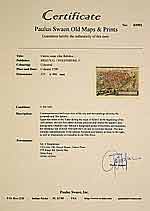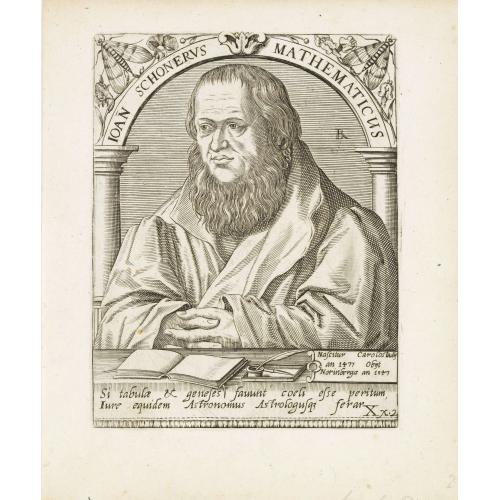Description
Schöner was a renowned and respected German polymath. It is best to refer to him using the usual 16th century Latin term "mathematicus", as the areas of study to which he devoted his life were very different from those now considered to be the domain of the mathematician. He was a priest, astronomer, astrologer, geographer, cosmographer, cartographer, mathematician, globe and scientific instrument maker and editor and publisher of scientific tests.
In his own time he enjoyed a European wide reputation as an innovative and influential globe maker and cosmographer and as one of the continents leading and most authoritative astrologers.[1] Today he is remembered as an influential pioneer in the history of globe making and as a man who played a significant role in the events that led up to the publishing of Copernicus' "De revolutionibus" in Nürnberg in 1543.
Schöner was born on January 16, 1477 in Karlstadt am Main in Lower Franconia. As with most Renaissance scholars nothing is known about his parents or his early life. He matriculated at the University of Erfurt in the winter semester 1494/5 and graduated Baccalaureus on 21 March 1498. He was appointed to a position in the school in Gemünden on 22 February 1499 and ordained as a Catholic priest in the Bishopric of Bamberg on the 13th June 1500. On the 2nd February 1500 he moved to Bamberg and was appointed chaplain in Hallstatt near Bamberg on the 18th April 1500. His next appointment was as vicar in his hometown Karlstadt from the 4th June 1504. Between the 4th May and the 29th October 1506 he was again in Bamberg before he returned to Karlstadt.
He was a pupil of the map maker Martin Waldseemüller. A copy of the Waldseemüller map which once was owned by Schöner is now in possession of the Library of Congress.
After 1506, and up to 1515 there are only indirect traces of Schöner's existence in the financial records of the bishopric and in the correspondence of Lorenz Beheim (?1457 - 1521), who after 24 years in Rome as chamberlain to Pope Alexander IV had returned to Bamberg in 1505 as a canon of the cathedral. 1526, he was called to Nurnberg as the first professor of mathematics at the newly founded gymnasium Aegidianum, a post he held till one year prior to his death. Already in Bamberg, he owned his own printing company and published many maps and globes.
The very first printed globe of the sky was made in his workshop in 1515. He made another globe in 1520. Schöner had also made still unpublished data of Mercury observations from Walther available to Copernicus, 45 observations in total, 14 of them with longitude and latitude. Copernicus used three of them in "De revolutionibus", giving only longitudes, and falsely attributing them to Schöner. The values differed slightly from the ones published by Schöner in 1544.
1538, Georg Joachim Rheticus, a young professor of mathematics at Wittenberg, stayed for some time with Schöner who convinced him to visit Nicolaus Copernicus in Frauenburg. In 1540, Rheticus dedicated the first published report of Copernicus work, the Narratio prima, to Schöner. As this was well received, Copernicus finally agreed to publish his main work, and Rheticus prepared Copernicus' manuscript for printing.
In Nürnberg, Schöner published in 1544 the astronomical observations of Regiomontanus and Walther, as well as manuscripts of Regiomontanus, which had been in the hand of Walther, as Observationes XXX annorum a I. Regiomontano et B. Walthero Norimbergae habitae, [4°, Norimb. 1544].
List of Explorers and Mapmakers [+]
FAQ - Guarantee - Shipping
Buying in the BuyNow Gallery
This item is available for immediate purchase when a "Add to Cart" or "Inquire Now" button is shown.
Items are sold in the EU margin scheme
Payments are accepted in Euros or US Dollars.
Authenticity Guarantee
 We provide professional descriptions, condition report and HiBCoR rating (based on 45 years experience in the map business)
We provide professional descriptions, condition report and HiBCoR rating (based on 45 years experience in the map business)
We fully guarantee the authenticity of items we sell. We provide a certificate of authenticity for each purchased item.
Condition / Coloring
We indicate the condition of each item and use our unnique HiBCoR grading system in which four key items determine a map's value: Historical Importance, Beauty, Condition/Coloring and Rarity.
We offer many maps in their original black and white condition. We do not systematically color-up maps to make them more sellable to the general public or buyer.
Copper engraved or wood block maps are always hand colored. Maps were initially colored for aesthetic reasons and to improve readability. Nowadays, it is becoming a challenge to find maps in their original colors and are therefor more valuable.
We use the following color keys in our catalog:
Original colors; mean that the colors have been applied around the time the map was issued.
Colored; If the colors are applied recently or at the end of the 20th century, then "colored", or "attractive colors" will be used.
Original o/l colors; means the map has only the borders colored at the time of publication.
Read more about coloring of maps [+]
FAQ
Please have a look for more information about buying in the BuyNow gallery.
Many answers are likely to find in the general help section.
Virtual Collection
![]()
With Virtual Collection you can collect all your favorite items in one place. It is free, and anyone can create his or her Virtual map collection.
Unless you are logged in, the item is only saved for this session. You have to be registed and logged-in if you want to save this item permanently to your Virtual Collection.
Read More [+]
Registering Here, it is and you do not need a credit card.
Add this item to
Virtual Collection
or click the following link to see my Virtual Collection.
Invoice
The invoice and certificates of authenticity are available in the client center >Invoices
| High-Resolution Digital Image Download | |
|
Paulus Swaen maintains an archive of most of our high-resolution rare maps, prints, posters and medieval manuscript scans. We make them freely available for download and study. Read more about free image download |
In accordance with the EU Consumer Rights Directive and habitually reside in the European Union you have the right to cancel the contract for the purchase of a lot, without giving any reason.
The cancellation period will expire 14 calendar days from the day after the date on which you or a third party (other than the carrier and indicated by you) acquires, physical possession of the lot. To exercise the right to cancel you must inform Paulus Swaen Europe bv, which is offering to sell the lot either as an agent for the seller or as the owner of the lot, of your decision to cancel this contract by a clear statement (e.g. a letter sent by post, or e-mail (amsterdam@swaen.com).
To meet the cancellation deadline, it is sufficient for you to send your communication concerning your exercise of the right to cancel before the cancellation period has expired.
